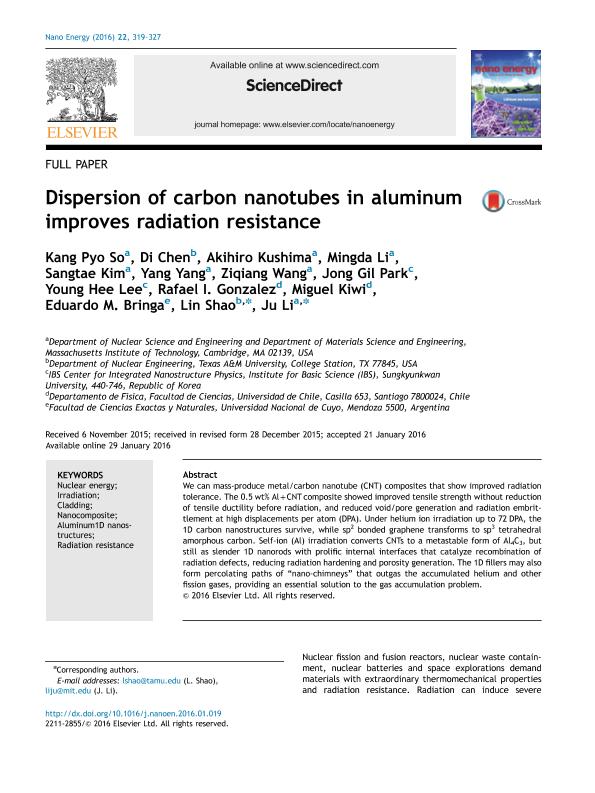Artículo
Dispersion of carbon nanotubes in aluminum improves radiation resistance
So, Kang Pyo; Chen, Di; Kushima, Akihiro; Li, Mingda; Kim, Sangtae; Yang, Yang; Wang, Ziqiang; Park, Jong Gil; Lee, Young Hee; Gonzalez, Rafael I.; Kiwi, Miguel; Bringa, Eduardo Marcial ; Shao, Lin; Li, Ju
; Shao, Lin; Li, Ju
 ; Shao, Lin; Li, Ju
; Shao, Lin; Li, Ju
Fecha de publicación:
04/2016
Editorial:
Elsevier
Revista:
Nano Energy
ISSN:
2211-2855
Idioma:
Inglés
Tipo de recurso:
Artículo publicado
Clasificación temática:
Resumen
We can mass-produce metal/carbon nanotube (CNT) composites that show improved radiation tolerance. The 0.5 wt% Al+CNT composite showed improved tensile strength without reduction of tensile ductility before radiation, and reduced void/pore generation and radiation embrittlement at high displacements per atom (DPA). Under helium ion irradiation up to 72 DPA, the 1D carbon nanostructures survive, while sp2 bonded graphene transforms to sp3 tetrahedral amorphous carbon. Self-ion (Al) irradiation converts CNTs to a metastable form of Al4C3, but still as slender 1D nanorods with prolific internal interfaces that catalyze recombination of radiation defects, reducing radiation hardening and porosity generation. The 1D fillers may also form percolating paths of "nano-chimneys" that outgas the accumulated helium and other fission gases, providing an essential solution to the gas accumulation problem.
Archivos asociados
Licencia
Identificadores
Colecciones
Articulos(CCT - MENDOZA)
Articulos de CTRO.CIENTIFICO TECNOL.CONICET - MENDOZA
Articulos de CTRO.CIENTIFICO TECNOL.CONICET - MENDOZA
Citación
So, Kang Pyo; Chen, Di; Kushima, Akihiro; Li, Mingda; Kim, Sangtae; et al.; Dispersion of carbon nanotubes in aluminum improves radiation resistance; Elsevier; Nano Energy; 22; 4-2016; 319-327
Compartir
Altmétricas



